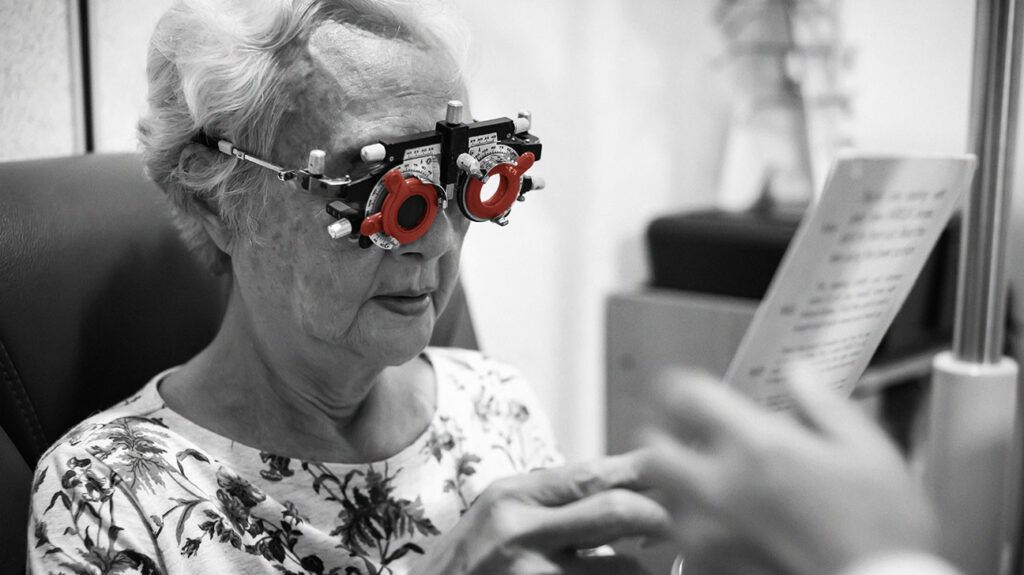The rate at which high myopic macular degeneration progresses differs for each person but tends to take several years. Some people with high myopia never advance into macular degeneration, and those who do are typically older.
High myopic macular degeneration, also known as maculopathy, occurs when the eye grows too long and stretches the retina — the area at the back of the eye. This causes other structures in the eye to break down.
This article explains the typical timeline for the progression of high myopic macular degeneration, the outlook, and when to speak with a doctor.

Globally, over 2 billion people have myopia, or nearsightedness, in which distant objects appear blurry and close objects appear clear. Out of this group, only 4% have high myopia, a more severe form of the condition.
Doctors measure the strength of the glasses or contact lenses a person needs to correct their vision in a unit called diopters (D). The higher the strength, the more myopic the person is, and the negative sign signifies nearsightedness.
The World Health Organization (WHO) considers high myopia to be over -5.00 D.
The rate at which a person’s eyes develop high myopic macular degeneration varies significantly from person to person, and the progression is not uniform for everyone.
Factors that may influence the speed of degeneration include the severity of the myopathy and the presence of additional eye conditions.
Learn more about myopic macular degeneration.
Common complications
The main complication of myopic macular degeneration is damage to the macula, the portion of the retina that creates central vision.
When this area of the retina stretches too much, an affected person may have difficulty seeing things directly in front of them. This damage is called macular degeneration.
Some people have a more severe version that health experts call wet macular degeneration. This occurs when abnormal blood cells grow behind the retina and leak blood, causing vision loss.
Learn the difference between wet and dry macular degeneration.
The typical degeneration timelines can vary depending on each individual, but progression to severe stages may not start until later adulthood. Some people may deteriorate rapidly, while it takes several years for others.
A 2020 study in Singapore found that, over 6 years, 1.2% of people over 40 years of age with myopia developed myopic macular degeneration, and 17% of people with myopic macular degeneration experienced progression.
Regular eye examinations can help detect the onset and advancement of high myopic macular degeneration.
Individuals with high myopia should maintain routine follow-ups with an eye care professional to monitor their ocular health and address any changes promptly.
Does high myopia always lead to macular degeneration?
High myopia does not always lead to macular degeneration. While people with high myopia have a higher risk of developing complications such as myopic macular degeneration, not everyone with high myopia will experience these changes.
Only individuals with pathological myopia, about 3% of people worldwide, carry the risk of degenerative changes.
According to the American Academy of Ophthalmology (AAO), in young people with high myopia, the condition typically stabilizes between 20 and 30 years of age.
The AAO suggests most people with this condition can correct their vision with glasses, contact lenses, or eye surgery.
The long-term outlook for people with high myopic macular degeneration is not always certain. It may depend on various factors, including the severity of the condition, how early treatment starts, genetic predisposition, and more.
A 2023 study predicts that around
Anytime a person experiences vision changes, it is best to speak with a doctor or ophthalmologist — a doctor specializing in eye health.
Symptoms of myopia can include:
- blurred distance vision
- squinting when looking at far objects
- sitting closer to the TV or holding books close to the face
Anyone with a myopia or high myopia diagnosis should attend regular checkup appointments with their ophthalmologist to monitor the condition.
High myopic macular degeneration occurs when severe myopia leads to deterioration of the central part of the retina, causing changes to central vision.
The progression rate of high myopic macular degeneration varies among individuals and may depend on factors such as the severity of the condition and the timeliness of treatment. However, not everyone with high myopia experiences macular degeneration.
It’s important for people with high myopia to attend regular eye exams to detect and manage the condition and any progression.
